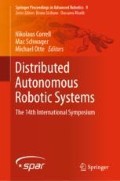Abstract
For complex and open-ended robot behaviors, it may prove to be important to find an intrinsic driver for pattern formation and self-organization. We apply methods of evolutionary computation and the idea of evolving prediction networks as world models in pair with action-selection networks to implement such a driver, especially in collective robot systems. Giving fitness for good predictions when evolving causes a bias towards easy-to-predict environments and behaviors in the form of emergent patterns, that is, minimal surprise. However, stimulating the emergence of complex behaviors requires to carefully configure allowed actions, sensor models, and the environment. While having shown the emergence of aggregation, dispersion, and flocking before, we increase the scenario’s complexity by studying self-assembly and manage its feasibility by limiting ourselves to a simulated grid world. We observe emergent patterns of self-assembled robots adapted to different environments. Finally, we investigate how minimal surprise can be augmented to engineer self-organization of desired patterns.
Access this chapter
Tax calculation will be finalised at checkout
Purchases are for personal use only
Notes
References
Bongard, J.C.: Evolutionary robotics. Commun ACM 56(8), 74–83 (2013)
Borkowski, R., Hamann, H.: Evolving robot swarm behaviors by minimizing surprise: results of simulations in 2-d on a torus. In: Evolving Collective Behaviors in Robotics Workshop, GECCO 2017. pp. 1679–1680. ACM (2017)
Der, R., Martius, G.: The playful machine: theoretical foundation and practical realization of self-organizing robots, vol. 15. Springer Science & Business Media (2012)
Friston, K.: The free-energy principle: a unified brain theory? Nat. Rev. Neurosci. 11(2), 127–138 (2010)
Groß, R., Gu, Y., Li, W., Gauci, M.: Generalizing GANs: a turing perspective. In: Advances in Neural Information Processing Systems (NIPS), pp. 6319–6329 (2017)
Hamann, H.: Evolution of collective behaviors by minimizing surprise. In: Sayama, H., Rieffel, J., Risi, S., Doursat, R., Lipson, H. (eds.) 14th International Conference on the Synthesis and Simulation of Living Systems (ALIFE 2014), pp. 344–351. MIT Press (2014)
Hamann, H.: Evolving prediction machines: collective behaviors based on minimal surprisal. In: International Conference on Genetic and Evolutionary Computation (GECCO 2014), pp. 31–32. ACM (2014) [extended abstract]
Hamann, H.: Swarm Robotics: A Formal Approach. Springer (2018)
Li, W., Gauci, M., Groß, R.: Turing learning: a metric-free approach to inferring behavior and its application to swarms. Swarm Intell. 10(3), 211–243 (2016)
Martius, G., Herrmann, J.M.: Taming the beast: guided self-organization of behavior in autonomous robots. In: Doncieux, S., Girard, B., Guillot, A., Hallam, J., Meyer, J.A., Mouret, J.B. (eds.) From Animals to Animals 11, vol. 6226, pp. 50–61. Springer (2010)
Nolfi, S., Parisi, D., Elman, J.L.: Learning and evolution in neural networks. Adapt. Behav. 3(1), 5–28 (1994)
Nolfi, S., Spalanzani, A.: Learning and Evolution: On the Effects of Directional Learning, p. 16 (2002)
Radford, A., Metz, L., Chintala, S.: Unsupervised representation learning with deep convolutional generative adversarial networks. arXiv:1511.06434 (2015)
Trianni, V.: Evolutionary Swarm Robotics—Evolving Self-Organising Behaviours in Groups of Autonomous Robots, Studies in Computational Intelligence, vol. 108. Springer, Berlin, Germany (2008)
Zahadat, P., Hamann, H., Schmickl, T.: Evolving Collective Behaviors with Diverse but Predictable Sensor States, vol. 2015, p. 174. MIT Press (2015) [extended abstract]
Zahadat, P., Hamann, H., Schmickl, T.: Evolving diverse collective behaviors independent of swarm density. In: Workshop Evolving Collective Behaviors in Robotics (GECCO 2015), pp. 1245–1246. ACM (2015) [extended abstract]
Author information
Authors and Affiliations
Corresponding author
Editor information
Editors and Affiliations
Rights and permissions
Copyright information
© 2019 Springer Nature Switzerland AG
About this paper
Cite this paper
Kaiser, T.K., Hamann, H. (2019). Self-assembly in Patterns with Minimal Surprise: Engineered Self-organization and Adaptation to the Environment. In: Correll, N., Schwager, M., Otte, M. (eds) Distributed Autonomous Robotic Systems. Springer Proceedings in Advanced Robotics, vol 9. Springer, Cham. https://doi.org/10.1007/978-3-030-05816-6_13
Download citation
DOI: https://doi.org/10.1007/978-3-030-05816-6_13
Published:
Publisher Name: Springer, Cham
Print ISBN: 978-3-030-05815-9
Online ISBN: 978-3-030-05816-6
eBook Packages: Intelligent Technologies and RoboticsIntelligent Technologies and Robotics (R0)

